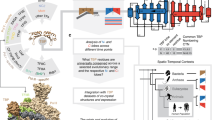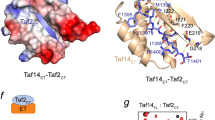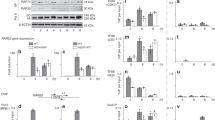Abstract
THE eukaryotic TATA-binding protein TBP, which is required for transcription by RNA polymerase II, is tightly associated with a particular set of factors in the TFIID complex1–5, and as such provides a target for transcriptional regulation exerted by upstream factors. An embryonic carcinoma (EC) cell-specific activity like that of the viral factor ElA has been implicated in the mediation of transactivation from the retinoic acid receptor to human TBP, but yeast TBP cannot perform this function6. Using TBP mutants with an altered TATA-box-binding specificity7, we show here that yeast TBP can mediate transcriptional activation in mammalian cells and that its inability to convey retinoic acid-dependent transactivation in EC cells is due to specific residues in its core region. These residues preclude a functional association with the cellular ElA-like activity. TBP is thus a target for retinoic acid-dependent transactivation in EC cells by providing a surface for interaction with the EC cell-specific ElA-like activity.
This is a preview of subscription content, access via your institution
Access options
Subscribe to this journal
Receive 51 print issues and online access
$199.00 per year
only $3.90 per issue
Buy this article
- Purchase on Springer Link
- Instant access to full article PDF
Prices may be subject to local taxes which are calculated during checkout
Similar content being viewed by others
References
Tanese, N., Pugh, B. F. & Tjian, R. Genes Dev. 5, 2212–2224 (1991).
Dynlacht, B. D., Hoey, T. & Tjian, R. Cell 66, 563–576 (1991).
Takada, R. et al. Proc. natn. Acad. Sci. U.S.A. 89, 11809–11813 (1992).
Zhou, Q., Lieberman, P. M., Boyer, T. G. & Berk, A. J. Genes Dev. 6, 1964–1974 (1992).
Zawel, L. & Reinberg, D. Curr. Opin. Cell Biol. 4, 488–495 (1992).
Berkenstam, A., Vivanco Ruiz, M. d. M., Barettino, D., Horikoshi, M. & Stunnenberg, H. G. Cell 69, 401–412 (1992).
Strubin, M. & Struhl, K. Cell 68, 721–730 (1992).
Horikoshi, N. et al. Proc. natn. Acad. Sci. U.S.A. 88, 5124–5128 (1991).
Meisterernst, M. & Roeder, R. G. Cell 67, 557–567 (1991).
Inostroza, J. A., Mermelstein, F. H., Ha, I., Lane, W. S. & Reinberg, D. Cell 70, 477–489 (1992).
Sadowski, I., Ma, I., Triezenberg, S. & Ptashne, M. Nature 334, 563–564 (1988).
White, J. et al. EMB0 J. 11, 2229–2240 (1992).
Hahn, S., Buratowski, S., Sharp, P. A. & Guarente, L. Cell 58, 1173–1181 (1989).
Horikoshi, M. et al. Nature 341, 299–303 (1988).
Eisenmann, D. M., Arndt K. M., Ricupero, S. L., Rooney, J. W. & Winston, F. Genes Dev. 6, 1319–1331 (1992).
Lee, W. S., Kao, C. C., Bryant, G. O., Liu, X. & Berk, A. J. Cell 67, 365–76 (1991).
Nikolov, D. B. et al. Nature 360, 40–46 (1992).
Stunnenberg, H. G. BioEssays 15, 309–315 (1993).
Hagemeier, C., Bannister, A. J., Cook, A. & Kouzarides, T. Proc. natn. Acad. Sci. U.S.A. 90, 1580–1584 (1993).
Seto, E. et al. Proc. natn. Acad. Sci. U.S.A. 89, 12028–12032 (1992).
Stringer, K. F., Ingles, C. J. & Greenblatt, J. Nature 345, 783–786 (1990).
Ingles, C. J., Shales, M., Cress, W. D., Triezenberg, S. J. & Greenblatt, J. Nature 351, 588–590 (1991).
Brou, C. et al. EMB0 J. 12, 489–499 (1993).
Imperiale, M. J., Kao, H. T., Feldman, L. T., Nevins, J. R. & Strickland, S. Molec. cell. Biol. 4, 867–874 (1984).
La Thangue, N. B. & Rigby, P. W. J. Cell 49, 507–513 (1987).
Schöler, H. R., Ciesiolka, T. & Gruss, P. Cell 66, 291–304 (1991).
Green, S., Issemann, I. & Sheer, E. Nucleic Acids Res. 16, 369 (1988).
Gill, G. & Tjian, R. Cell 65, 333–340 (1991).
Hoey, T., Dynlacht, B. D., Peterson, M. G., Pugh, B. F. & Tjian, R. Cell 61, 1179–1186 (1990).
Pratt, M. A. C., Kralova, J. & McBurney, M. W. Molec. cell. Biol. 10, 6445–6453 (1990).
Vriend, G. J. J. molec. Graph. 8, 52–56 (1990).
Author information
Authors and Affiliations
Rights and permissions
About this article
Cite this article
Keaveney, M., Berkenstam, A., Feigenbutz, M. et al. Residues in the TATA-binding protein required to mediate a transcriptional response to retinoic acid in EC cells. Nature 365, 562–566 (1993). https://doi.org/10.1038/365562a0
Received:
Accepted:
Issue Date:
DOI: https://doi.org/10.1038/365562a0
This article is cited by
-
Mammalian transcription factors in yeast: strangers in a familiar land
Nature Reviews Molecular Cell Biology (2002)
-
Effects of activation-defective TBP mutations on transcription initiation in yeast
Nature (1994)
-
2.1 Å resolution refined structure of a TATA box-binding protein (TBP)
Nature Structural & Molecular Biology (1994)
-
Opening the gateway
Nature (1993)
Comments
By submitting a comment you agree to abide by our Terms and Community Guidelines. If you find something abusive or that does not comply with our terms or guidelines please flag it as inappropriate.



